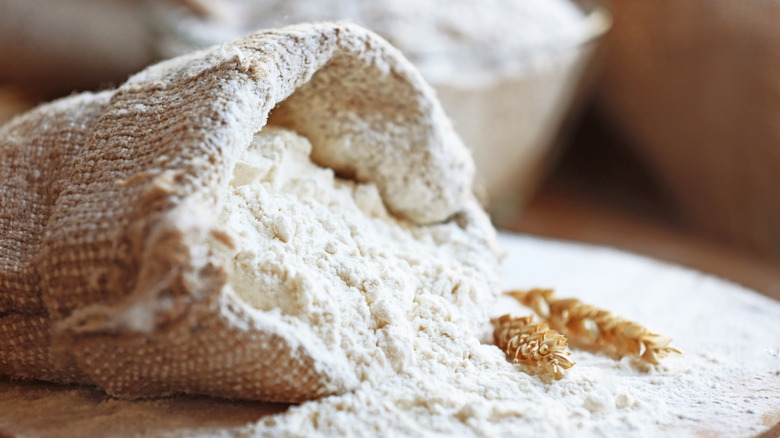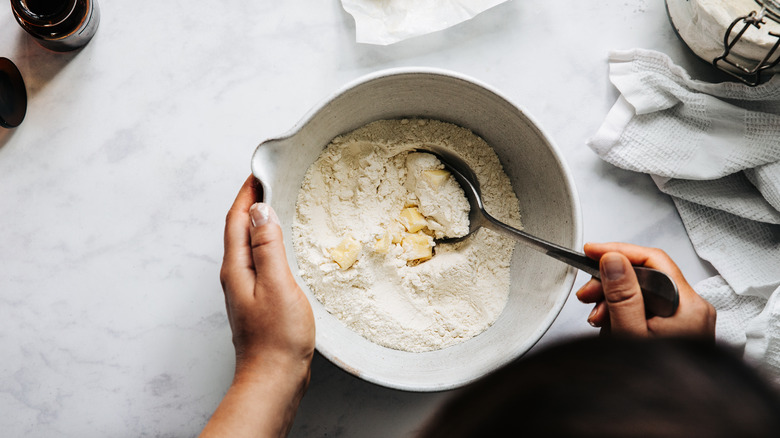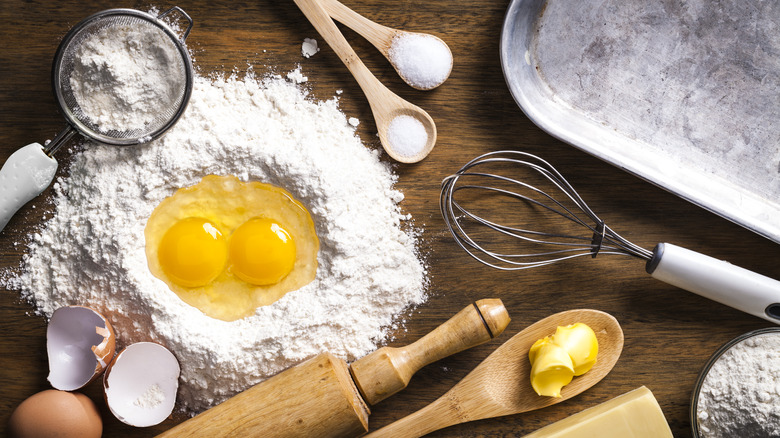The Best Swap For Cake Flour In A Pinch
If you're baking a cake and can only seem to get your hands on regular, all-purpose flour instead of cake flour, don't fret. There's a pretty easy substitute for cake flour that you've likely already got at home (and that's easy to buy if not): Cornstarch. The substitution here is pretty easy: If you need a cup of cake flour, measure it out with the all-purpose flour. Remove two tablespoons of the flour, and substitute in two tablespoons of cornstarch, and you're good to go.
Pay attention to using cornstarch and not corn flour — these products are sometimes wrongly thought to be the same thing, and their differences are relevant here. Cake flour creates a soft cake. It's lower in protein than other flours, and more protein means more gluten (and a chewier end product). Corn flour has protein in it, so you'll end up making your cake more glutinous if you accidentally sub in corn flour. Cornstarch doesn't have protein, and like the name suggests, it's full of starch — cake flour is similarly starchy, so using cornstarch helps nudge the recipe towards a similar formulation.
What is cake flour, and why use it?
As the name suggests, cake flour is good for cakes, although it can be used in other mostly sweet treats as well like cookies and pies. It's particularly useful for certain cake recipes like red velvet cake. Occasional bakers may not want to bother with having multiple different types of flour in their pantry, but those who are serious about cakes will often swear by it. It's made from a different type of wheat than all-purpose flour: This wheat is "softer," meaning it has a lower protein content. Since more protein leads to more gluten developing in the baking process, and baked goods with more gluten tend to be chewier and tougher, cake flour takes things in the other direction, giving you a softer, spongier baked good.
Cake flour is also more finely ground than other flours. This allows it to soak up more liquid, and overall means that cake flour will lend itself to a sturdy cake that doesn't sink more than other, coarser ground flours. You may also see pastry flour out there — it has similar properties to cake flour but isn't the same. Since pastry flour has more protein than its cakey counterpart, it'll lead to a little more gluten formation than cake flour, although it's still lower in protein than even regular all-purpose flour.
What if you use other flour types for cakes?
There's a number of different types of wheat flour out there, and they'll each deliver different results if you use them in cakes (of course, the results may vary depending on the recipe, too). Beyond cake flour, the main ones are all-purpose flour and bread flour. The latter two have more protein than cake flour — cake flour maxes out around 8% protein, all-purpose at 12%, and bread flour at 15%. As mentioned, more protein means more gluten, which means a chewier texture that people may not love in a cake. They're also coarser than cake flour, particularly the bread flour. The coarseness could mean if you sub in other flours, the cake may have a rougher texture (not the "fine crumb" that you desire). Even more importantly, they'll absorb less moisture, so they could lead to a collapsed or sloppier final product, or at the very least, it won't rise as much as with cake flour. But these problems will be more acute with bread flour — generally speaking, you can usually get a serviceable cake out of all-purpose flour, even without the cornstarch substitute.
These different flour types are sometimes called "strong" and "weak" flours: The low-protein ones like cake flour are "weak" (because they create less gluten) and higher-protein options like bread flour are "strong."


